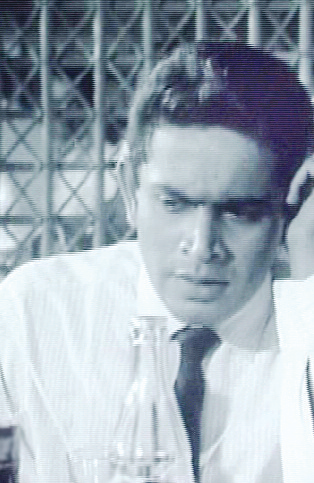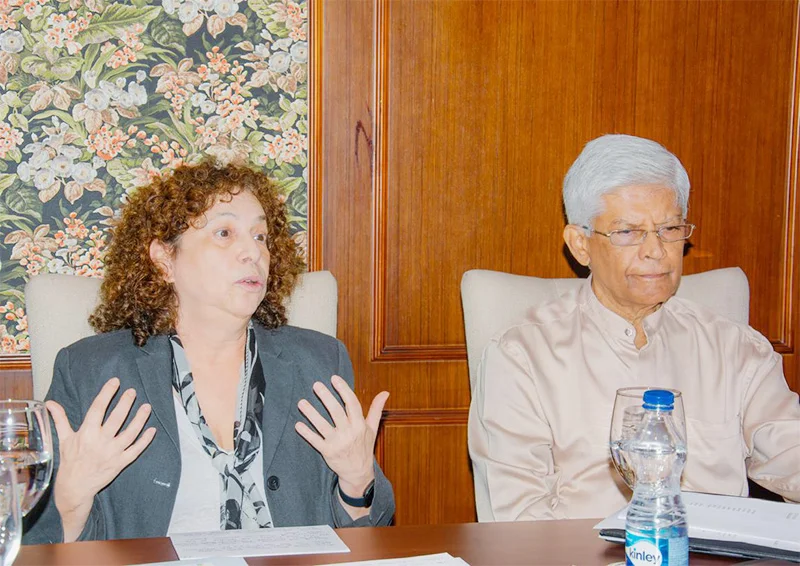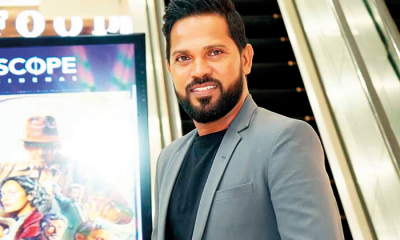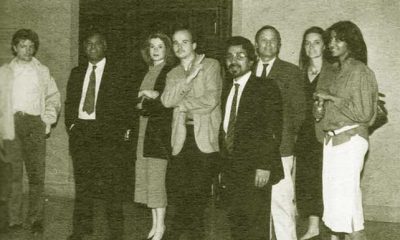Features
Tony Ranasinghe ,in full flow

By Uditha Devapriya
This is the first in a series of candid vignettes about Tony Ranasinghe, one of the most complex actors we ever had. It is based on an interview the writer did with him in 2014.Marlon Brando strode the theatre like the colossus that he was, changing the face of acting in a way none of his predecessors had. Yet, even after the shock of seeing him in A Streetcar Named Desire, nothing quite prepared people for his role as Mark Antony in Julius Caesar. For me, this is the ultimate Brando performance; it is so, simply because, in a cast filled with the most distinguished thespians of the day – from John Gielgud to James Mason – Brando stands apart, the obvious exception, the odd man out, the black sheep. When Antony weeps over Caesar’s body, he doesn’t wax eloquent, he mumbles.
The performance startled audiences, shocked others, and scandalised a few. In Sri Lanka, a new generation of actors had begun to crop up – they had left school and had moved to Colombo, in search of employment – and they came across Brando. Most of them took to him, entranced by his interpretation of a character which had, for so long, been deemed sacrosanct by thespians, and stage directors. “When you see Gielgud and Mason, and Brando enters the story, things never seem the same,” Cyril Wickramage told me. “I can’t think of another actor who so enthralled me,” Ravindra Randeniya, who went on to play Stanley in Dhamma Jagoda’s adaptation of A Streetcar Named Desire, recalled.

There’s probably no better and more fitting symbol of Brando’s influence on acting in Sri Lanka than Gamini Fonseka. The carelessness, the disregard for the other characters, the sleek agility, and the tendency to project himself, rather than the character he is playing – these are hallmarks of a Brando performance, and they are there in Fonseka’s performances, too. “I chose him because he was the ideal fit for Simon Kabilana,” Lester Peries told me, talking about Yuganthaya. I saw his point: at that point, Fonseka was the only man in the country who could play Kabilana. He had progressed from the naivete of his early years – captured by Peries himself, in Gamperaliya – into a kind of supreme self-confidence, which Brando had, by that time, epitomised. To see Fonseka was to savour him.
When I met him, in 2014, Tony Ranasinghe was not doing well. He did not want to meet me at first: he was doubtful about whether we’d have a fruitful conversation. Having read one gossipy piece after another in the papers, I couldn’t blame him. And yet, I wanted to have a serious conversation with him, about what he thought of his profession. After drinking his medicine, he rambled on and on. I sensed that he preferred me gone. Just three years out of school, with no aim in life other than meeting those who had contributed to our cultural landscapes, I was probably an outsider in his eyes. But, as the minutes wore on, he began to relax. Something in him softened. We began to have that serious conversation.
Much to my surprise, Ranasinghe did not think highly of Brando. He preferred to talk about Shakespeare – he had translated Shakespeare to Sinhala, one of the first in his time to do so – and about Kurosawa’s Ran, which he rated as among the finest adaptations of his plays. Perhaps, inevitably, we got around to Brando’s Mark Antony. The lines under Ranasinghe’s eyes darkened somewhat. “That is not a performance I rate highly,” he told me. I thought of telling him how eloquently Cyril Wickramage had waxed on it, but soon thought otherwise. I was, after all, sitting in front of one of Sri Lanka’s finest actors, and if he didn’t like Brando’s acting, who was I to disagree? “He doesn’t act, he mumbles, contrary to how a Shakespeare performance should be played out,” he told me.
He then moved on to Brando’s later work. “Five or so years after Julius Caesar, he took part in a film called The Ugly American. To me, that signified Brando’s failures as an actor.” The Ugly American is not one of Brando’s finest performances – the acting is jittery. Yet, to take such a role, and ignore his other credits – such as the widowed husband in Last Tango in Paris or the Don in The Godfather, seemed unfair. “In his later years, he unbuckled himself so badly that he lost all sense of discipline.” He was referring to Brando’s lesser years – his unjustifiably expensive cameo in Superman, and his even more unjustifiably unfocused role in The Island of Dr Moreau. But what of the interregnum, his great years? To Ranasinghe, these seemed dispensable, quirks in a jittery career. In a big way his attitude reflected his own notions of acting, which stemmed from his career and work.
Not unlike most of his contemporaries, Tony Ranasinghe came from a theatrical tradition. At De La Salle College, in Modera, he had involved himself in literary activities. At S. Thomas’, Gamini Fonseka had done the same. But for Ranasinghe, these activities instilled in him a love for the literary and the dramatic. The rift between theatre and cinema, particularly in acting, is too discernible to ignore. In that sense Ranasinghe emerged as a counterpoint to Fonseka. Ever respectful of the stage, he never quite left it. In Sugathapala Silva’s group, Ape Kattiya, he found not so much a vocation as a refuge from the dreariness of a day job. And with the plays he took part in there – like Boarding Karayo – he discovered his niche, as the bewildered everyman. This was to be his niche in the movies, too.
Lester Peries’s film of Gamperaliya focuses on the relationship between Nanda, Piyal, and Jinadasa. As such, it never gives the attention they deserve to the side characters. These characters were played by the Ape Kattiya troupe. Ranasinghe got the role of Baladasa, acting beside Wickrema Bogoda, Anula Karunatilake, and G. W. Surendra, all of whom had been trained and tutored by Sugathapala de Silva. Peries opted for these actors in his later work, epitomised unforgettably by his pairing of Bogoda and Karunatilake in the greatest love story adapted here, Golu Hadawatha. What he did for Bogoda and Karunatilake there, he did for Ranasinghe in his second film after Gamperaliya, Delovak Athara.

Towards the end of Delovak Athara, Ranasinghe sheds a tear. He is at his wit’s end: he has just told his mother and father that he will not let their servant-boy take the fall for his crime. Caught between two worlds – literally, the title of the film – he finds himself lost in this world, and in his thoughts. Then Willie Blake’s camera “frames him between two tree trunks, and catches the slow trickle of a tear down his cheek.” In The Lonely Artist, Philip Cooray contends that the scene lacks emotional depth: he argues that “the objectivity is all”, and that we “admire and appreciate, from afar.” In other words, Ranasinghe both moves us towards empathy for his plight and cuts us off from him.
If it didn’t do anything else, Delovak Athara revealed Ranasinghe as a leading man, but one capable of great emotional intensity. Contrary to what one Indian critic wrote on him, that he differed from the namby-pamby naivete of Indian actors, Ranasinghe did epitomise that kind of performance. Peries admittedly muted the emotional cadences of his character in Delovak Athara, but this did not, and could not, mute the actor’s intensity. There are scenes and sequences of great, raw emotional power in that film – such as when he confronts his girlfriend and confesses his crime to her – where you see nothing but desperation in his eyes. In Getawarayo, Gamini Fonseka typifies this same desperation, but it’s Ranasinghe who embodies it in a way that makes you really feel for him.
It’s hard to put a finger on such performances. Ranasinghe may have disagreed, but there is in his role as Nissanka, in Delovak Athara, a tinge of the early Brando and the early James Dean. Swineetha Weerasinghe once compared him to Gregory Peck, which is correct if you consider Peck’s patrician airs. But Ranasinghe lacks Peck’s seriousness, the humourless and emotionless appeal of Peck’s characters. The more comparable actors to his characters are James Dean and Marlon Brando. Except that where Dean and Brando tend to give way to their frenzies and emotional histrionics, Ranasinghe tones down, and goes in search of an emotional centre. In Delovak Athara he finds this centre in Weerasinghe’s character, Chitra; in Parasathumal, he finds it in Punya Heendeniya’s character.
The actor most comparable to Ranasinghe’s performances at this point was Montgomery Clift. Deeply sensitive and highly vulnerable, Montgomery’s characters symbolised a new, frustrated American youth, the sort that Dean and Brando would take even further. They are comparable to Ranasinghe’s characters, because, like the latter, they both cry out and tone down. In From Here to Eternity and A Place in the Sun, Clift grits his teeth, less out of anger than out of a frustrated sense of self-worth. He is angry not at what the world is doing to him, but at his inability to respond to the world.
In Delovak Athara Ranasinghe finds himself dominated by three women: his mother, his fiancée, and his friend Chitra. This is the type of situation Clift found his forte in, the type that distinguished Ranasinghe’s characters from Brando’s: whereas the latter couldn’t have bothered less about his predicament, Ranasinghe couldn’t have bothered more about his. In the end, that’s what made his performance in Peries’s film so evocative: not because he was sensitive, but because he cared, and got us to care about him.
(The writer is an international relations analyst, researcher, and columnist who can be reached at udakdev1@gmail.com)
Features
SL urged to use GSP+ to the fullest to promote export development

 Sri Lanka needs to take full stock of its current economic situation and use to the maximum the potential in its GSP+ facility for export sector growth. In the process, it should ensure that it cooperates fully with the European Union. The urgency of undertaking these responsibilities is underscored by the issues growing out of the recent US decision to sweepingly hike tariffs on its imports, though differentially.
Sri Lanka needs to take full stock of its current economic situation and use to the maximum the potential in its GSP+ facility for export sector growth. In the process, it should ensure that it cooperates fully with the European Union. The urgency of undertaking these responsibilities is underscored by the issues growing out of the recent US decision to sweepingly hike tariffs on its imports, though differentially.
These were principal ‘takes’ for participants in the Pathfinder Foundation’s Ambassadors’ Roundtable forum held on April 8th at the Colombo Club of the Taj Samudra. The main presenter at the event was Ms. Carmen Moreno Raymundo, Ambassador of the European Union to Sri Lanka and the Maldives. The forum was chaired by Ambassador Bernard Goonetilleke, Chairman, Pathfinder Foundation. The event brought together a cross-section of the local public, including the media.
Ms. Moreno drew attention to the fact Sri Lanka is at present severely under utilizing its GSP+ facility, which is the main means for Sri Lanka to enter the very vast EU market of 450 million people. In fact the EU has been Sri Lanka’s biggest trading partner. In 2023, for instance, total trade between the partners stood at Euros 3.84 billion. There is no greater market but the EU region for Sri Lanka.
‘However, only Sri Lanka’s apparel sector has seen considerable growth over the years. It is the only export sector in Sri Lanka which could be said to be fully developed. However, wider ranging export growth is possible provided Sri Lanka exploits to the fullest the opportunities presented by GSP+.’
Moreno added, among other things: ‘Sri Lanka is one among only eight countries that have been granted the EU’s GSP+ facility. The wide-ranging export possibilities opened by the facility are waiting to be utilized. In the process, the country needs to participate in world trade in a dynamic way. It cannot opt for a closed economy. As long as economic vibrancy remains unachieved, Sri Lanka cannot enter into world trading arrangements from a strong position. Among other things, Sri Lanka must access the tools that will enable it to spot and make full use of export opportunities.
‘Sri Lanka must facilitate the private sector in a major way and make it possible for foreign investors to enter the local economy with no hassle and compete for local business opportunities unfettered. At present, Lanka lacks the relevant legal framework to make all this happen satisfactorily.
‘Sri Lanka cannot opt for what could be seen as opaque arrangements with bilateral economic partners. Transparency must be made to prevail in its dealings with investors and other relevant quarters. It’s the public good that must be ensured. The EU would like to see the local economy further opening up for foreign investment.
‘However, it is important that Sri Lanka cooperates with the EU in the latter’s efforts to bring about beneficial outcomes for Sri Lankans. Cooperation could be ensured by Sri Lanka fully abiding by the EU conditions that are attendant on the granting of GSP+. There are, for example, a number of commitments and international conventions that Sri Lanka signed up to and had promised to implement on its receipt of GSP+ which have hitherto not been complied with. Some of these relate to human rights and labour regulations.
‘Successive governments have pledged to implement these conventions but thus far nothing has happened by way of compliance. GSP+ must be seen as an opportunity and not a threat and by complying with EU conditions the best fruits could be reaped from GSP+. It is relevant to remember that GSP+ was granted to Sri Lanka in 2005. It was suspended five years later and restored in 2017.
‘The importance of compliance with EU conditions is greatly enhanced at present in view of the fact that Sri Lanka is currently being monitored by the EU with regard to compliance ahead of extending GSP+ next year. A report on Sri Lanka is due next year wherein the country’s performance with regard to cooperating with the EU would be assessed. The continuation of the facility depends on the degree of cooperation.
‘A few statistics would bear out the importance of Sri Lanka’s partnership with the EU. For example, under the facility Sri Lanka benefits from duty free access in over 66% of EU tariff lines. The highest number of tourist arrivals in Sri Lanka in 2023 was from the EU’s 27 member states. Likewise, the EU’s 27 member states rank second in the origin of inflows of foreign exchange to Sri Lanka; with Italy, France and Germany figuring as the main countries of origin. Eighty five percent of Sri Lanka’s exports to the EU market benefits from GSP+. Thus, the stakes for the country are high.’
Meanwhile, President, In-house Counsel & Legal Advisor, The European Chamber of Commerce of Sri Lanka, John Wilson said: ‘GSP+ should be seen as not only an opportunity but also as a necessity by Sri Lanka in the current international economic climate. ‘Implementation of local laws is what is needed. Considering the pressures growing out of the US imposed new tariff regime, a good dialogue with the EU is needed.
‘Sri Lanka’s level of business readiness must be upped. Among the imperatives are: An electronic procurement process, Customs reforms, a ‘National Single Window’, stepped-up access to land by investors, for example, a clear policy framework on PPPs and reform of the work permits system.’
It ought to be plain to see from the foregoing that Sri Lanka cannot afford to lose the GSP+ facility if it is stepped-up economic growth that is aimed at. It would be in Sri Lanka’s best interests to remain linked with the EU, considering the aggravated material hardships that could come in the wake of the imposition of the US’ new tariff regime. Sri Lanka would need to remain in a dialogue process with the EU, voice its reservations on matters growing out of GSP+, if any, iron out differences and ensure that its national interest is secured.
Features
SENSITIVE AND PASSIONATE…

Chit-Chat
Chiara Tissera
Mrs. Queen of the World Sri Lanka 2024, Chiara Tissera, leaves for the finals, in the USA, next month
I had a very interesting chat with her and this is how it all went:
1. How would you describe yourself?
I am a sensitive and passionate individual who deeply cares about the things that matter most to me. I approach life with a heart full of enthusiasm and a desire to make meaningful connections.
2. If you could change one thing about yourself, what would it be?
Actually, I wouldn’t change a thing about myself because the person I am today, both inside and out, is the result of everything I’ve experienced. Every part of me has shaped who I am, so I embrace both my strengths and imperfections as they make me uniquely me.
3. If you could change one thing about your family, what would it be?
If there’s one thing I could change about my family, it would be having my father back with us. Losing him six years ago left a void that can never be filled, but his memory continues to guide and inspire us every day.
4. School?
I went to St. Jude’s College, Kurana, and I’m really proud to say that the lessons I gained during my time there have shaped who I am today. My school and teachers instilled in me values of hard work, perseverance and the importance of community, and I carry those lessons with me every day. I was a senior prefect and was selected the Deputy Head Prefect of our college during my tenure.
5. Happiest moment?
The happiest moment of my life so far has been winning the Mrs. Sri Lanka 2024 for Queen of the World. It was a dream come true and a truly unforgettable experience, one that fills me with pride and gratitude every time I reflect on it.
6. What is your idea of perfect happiness?
Happiness is a deeply personal and multifaceted feeling that often comes from a sense of contentment, fulfillment and well-being. For me, perfect happiness is in moments of joy, peace and accomplishments … and also being surrounded by my loved ones.
7. Are you religious?
Yes, I’m a very religious person. And I’m a firm believer in God. My faith guides me through life, providing strength, dedication and a sense of peace in every situation. I live by the quote, ‘Do your best, and God will do the rest.’
8. Are you superstitious?
I’m not superstitious. I believe in making my own decisions and relying on logic and faith rather than following superstitions.
9. Your ideal guy?
My ideal guy is my husband. He is compassionate, understanding and is always there to support me, no matter what. He’s my rock and my best friend – truly everything I could ever want in a partner.
10. Which living person do you most admire?
The living person I admire the most is definitely my mummy. Her strength, love and unwavering support has shaped me into who I am today. She is my role model and she inspires me every day with her wisdom and kindness.
11. Your most treasured possession?
My most treasured possession is my family. They are the heart of my life, providing me with love, support and strength. Their presence is my greatest blessing.
12. If you were marooned on a desert island, who would you like as your companion?
I would like to have my spouse as my companion. Together, we could make the best of the situation, supporting each other, sharing moments of laughter and finding creative ways to survive and thrive.
13. Your most embarrassing moment?
There’s quite a few, for sure, but nothing is really coming to mind right now.
14. Done anything daring?
Yes, stepping out of my comfort zone and taking part in a pageant. I had no experience and was nervous about putting myself out there, but I decided to challenge myself and go for it. It pushed me to grow in so many ways—learning to embrace confidence, handle pressure, and appreciate my own uniqueness. The experience not only boosted my self-esteem but also taught me the value of taking risks and embracing new opportunities, even when they feel intimidating.”
15. Your ideal vacation?
It would be to Paris. The city has such a magical vibe and, of course, exploring the magical Eiffel Tower is in my bucket list. Especially the city being a mix of history culture and modern life in a way that feels timeless, I find it to be the ideal vacation spot for me.
16. What kind of music are you into?
I love romantic songs. I’m drawn to its emotional depth and the way they express love, longing a connection. Whether it’s a slow ballad, a classic love song or a more modern romantic tune these songs speak to my heart.
17. Favourite radio station?
I don’t have a specific radio station that I like, but I tend to enjoy a variety of stations, depending on my mood. Sometimes I’ll tune into one for a mix of popular hits, other times I might go for something more relaxing, or a station with a certain vibe. So I just like to keep it flexible and switch it up.
18. Favourite TV station?
I hardly find the time to sit down and watch TV. But, whenever I do find a little spare time, I tend to do some spontaneous binge – watching, catching whatever interesting show is on at that moment.
19 What would you like to be born as in your next life?
Mmmm, I’ve actually not thought about it, but I’d love to be born as someone who gets to explore the world freely – perhaps a bird soaring across continents.
20. Any major plans for the future?
Let’s say preparing and participating in the international pageant happening in the USA this May. It’s an exciting opportunity to represent myself and my country on a global stage. Alongside this, I am dedicated to continuing my social service work as a title holder, striving to make a meaningful difference in the lives of others through my platform.
Features
Fresher looking skin …

 The formation of wrinkles and fine lines is part of our ageing process. However, if these wrinkles negatively impact appearance, making one look older than they actually are, then trying out some homemade remedies, I’ve listed for you, this week, may help in giving your skin a fresher look.
The formation of wrinkles and fine lines is part of our ageing process. However, if these wrinkles negatively impact appearance, making one look older than they actually are, then trying out some homemade remedies, I’ve listed for you, this week, may help in giving your skin a fresher look.
* Banana:
Bananas are considered to be our skin’s best friend. They contain natural oils and vitamins that work very perfectly to boost our skin health. Skincare experts recommend applying the banana paste to the skin.
Take a ripe banana and mash a quarter of it until it becomes a smooth paste. Apply a thin layer of the banana paste on your skin and allow it to sit for 15 to 20 minutes before washing it off with warm water.
* Olive Oil:
Olive oil works as a great skin protector and many types of research suggest that even consuming olive oil may protect the skin from developing more wrinkles. Olive oil contains compounds that can increase the skin’s collagen levels. Yes, olive oil can be used as a dressing on your salads, or other food, if you want to consume it, otherwise, you can apply a thin layer of olive oil on your face, neck and hands and let it stay overnight.
* Ginger:
Ginger serves to be a brilliant anti-wrinkle remedy because of the high content of antioxidants in it. Ginger helps in breaking down elastin, which is one of the main reasons for wrinkles. You can have ginger tea or grate ginger and have it with honey, on a regular basis.
* Aloe Vera:
The malic acid present in Aloe Vera helps in improving your skin’s elasticity, which helps in reducing your wrinkles. Apply the gel once you extract it from the plant, and leave it on for 15-20 minutes. You can wash it off with warm water.
* Lemons:
Lemons contain citric acid, which is a strong exfoliant that can help you get rid of your dead skin cells and wrinkles. Also, as an astringent and a cleansing agent, it helps to fade your wrinkles and fine lines. You can gently rub a lemon slice in your wrinkled skin and leave it on for 10-15 minutes. Rinse afterwards and repeat this process two to three times a day.
* Coconut Oil:
Coconut oil contains essential fatty acid that moisturises the skin and helps to retain its elasticity. You can directly apply the coconut oil, and leave it overnight, after gently massaging it, for the best results.
-

 Business3 days ago
Business3 days agoColombo Coffee wins coveted management awards
-

 Business5 days ago
Business5 days agoDaraz Sri Lanka ushers in the New Year with 4.4 Avurudu Wasi Pro Max – Sri Lanka’s biggest online Avurudu sale
-

 Features4 days ago
Features4 days agoStarlink in the Global South
-

 Business6 days ago
Business6 days agoStrengthening SDG integration into provincial planning and development process
-

 Business5 days ago
Business5 days agoNew SL Sovereign Bonds win foreign investor confidence
-

 Features1 day ago
Features1 day agoSri Lanka’s Foreign Policy amid Geopolitical Transformations: 1990-2024 – Part III
-

 Features4 days ago
Features4 days agoModi’s Sri Lanka Sojourn
-

 Midweek Review1 day ago
Midweek Review1 day agoInequality is killing the Middle Class


















